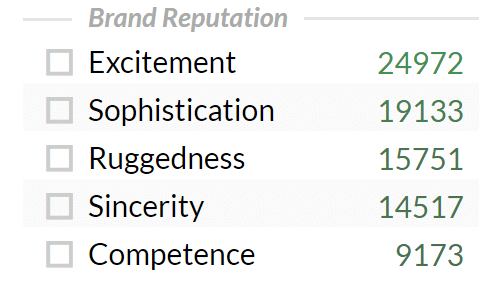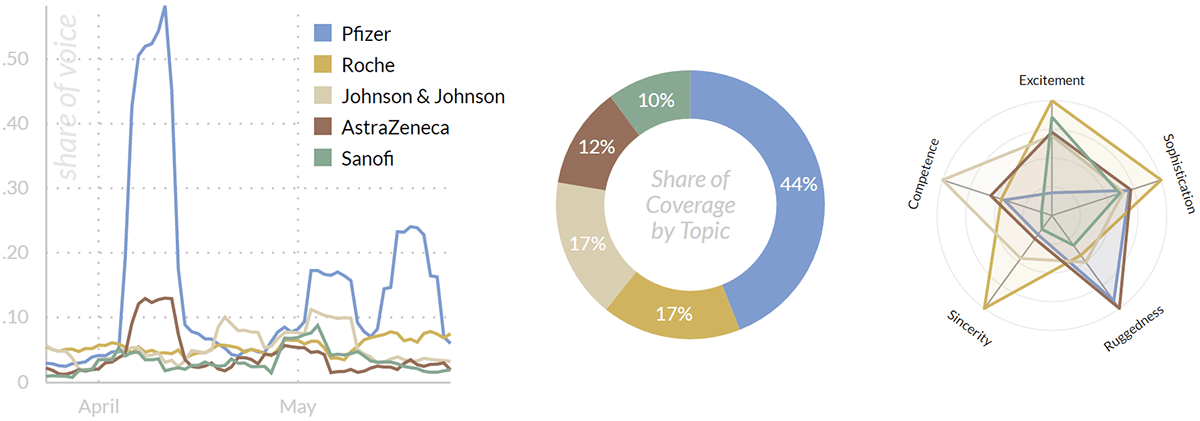Brand Reputation Radar Chart
Brands are highly valuable assets of organizations. Consumers who discuss brands on social media platforms actively participate in a knowledge co-creation process [5]. They not only respond to brand communication but also play a pivotal role in shaping brand reputation – e.g. when repeating or commenting on a story via Twitter or Facebook. This reflects their personal connection to the brand and the collective nature of brand authorship.
Online Brand Management
Co-creation processes and collective brand authorship challenge accepted branding truths. The term open source branding [2] refers to consumers who create and disseminate branded content. In such cases, brand managers exert less direct control and face the risk of postings that contest the brand’s aspired identity [3]. A deep understanding of the perceptions and opinions of online stakeholders therefore helps to increase brand performance.
Visualizing Brand Reputation
The  Brand Reputation Radar is a visual tool that enables such a deep understanding by creating a unique profile of a brand along a number of customizable categories. Marketing and communication managers can easily define and update these dimensions, or apply established classifications such as the “Dimensions of Brand Personality” by Jennifer L. Aaker [1]. Each axis of the radar chart represents one such dimension. The colored lines connecting the data points represent the selected brands. The chart supports ad-hoc data exploration and shows updates in real time – since users can define topics on the fly, the comparison is not restricted to brands but can also include other entities such as products, persons, or organizations.
Brand Reputation Radar is a visual tool that enables such a deep understanding by creating a unique profile of a brand along a number of customizable categories. Marketing and communication managers can easily define and update these dimensions, or apply established classifications such as the “Dimensions of Brand Personality” by Jennifer L. Aaker [1]. Each axis of the radar chart represents one such dimension. The colored lines connecting the data points represent the selected brands. The chart supports ad-hoc data exploration and shows updates in real time – since users can define topics on the fly, the comparison is not restricted to brands but can also include other entities such as products, persons, or organizations.
Decision Support
The ability to structure and visualize the perception of brands helps brand owners to “navigate” their brand and assess whether consumer opinions reflect the desired message [6]. The decision support tools of webLyzard including the WYSDOM Success Metric and the Brand Reputation Radar assist brand managers in this navigation process. They help them to:
- listen actively and gain a deep understanding of online interactions to assess communication strategies and improve consumer engagement – brands “cannot take advantage of organic content if they do not know what is going on” [2];
- integrate user-generated content on social media platforms into their communication mix to disseminate compelling brand stories [3];
- coordinate brand stories across channels and geographic locations, taking into account cultural differences and the dynamic nature of stakeholder perceptions;
- provide a theme with variations, not a monotone; a compelling brand story, not a slogan; a successful and reinforcing pattern, not a static message [4].
References
- Aaker, J.L. (1997). Dimensions of Brand Personality, Journal of Marketing Research, 34(3): 347-356.
- Fournier, S. and Avery, J. (2011). The Uninvited Brand, Business Horizons, 54(3): 193-207.
- Gensler, S., Völckner, F., Liu-Thompkins, Y. and Wiertz, C. (2013). Managing Brands in the Social Media Environment, Journal of Interactive Marketing, 27(4): 242-256.
- Jones, R. (2012). Five Ways Branding is Changing, Journal of Brand Management, 20(2): 77-79.
- Scharl, A., Hubmann-Haidvogel, A., Sabou, M., Weichselbraun, A. and Lang, H.-P. (2013). From Web Intelligence to Knowledge Co-Creation – A Platform to Analyze and Support Stakeholder Communication, IEEE Internet Computing, 17(5): 21-29.
- Singh, S. and Sonnenburg, S. (2012). Brand Performances in Social Media, Journal of Interactive Marketing, 26(4): 189-197.
Available since December 2013, fully integrated with the WYSDOM Success Metric, and with advanced configuration settings as of release 2014-12.1 (Gila Monster).




